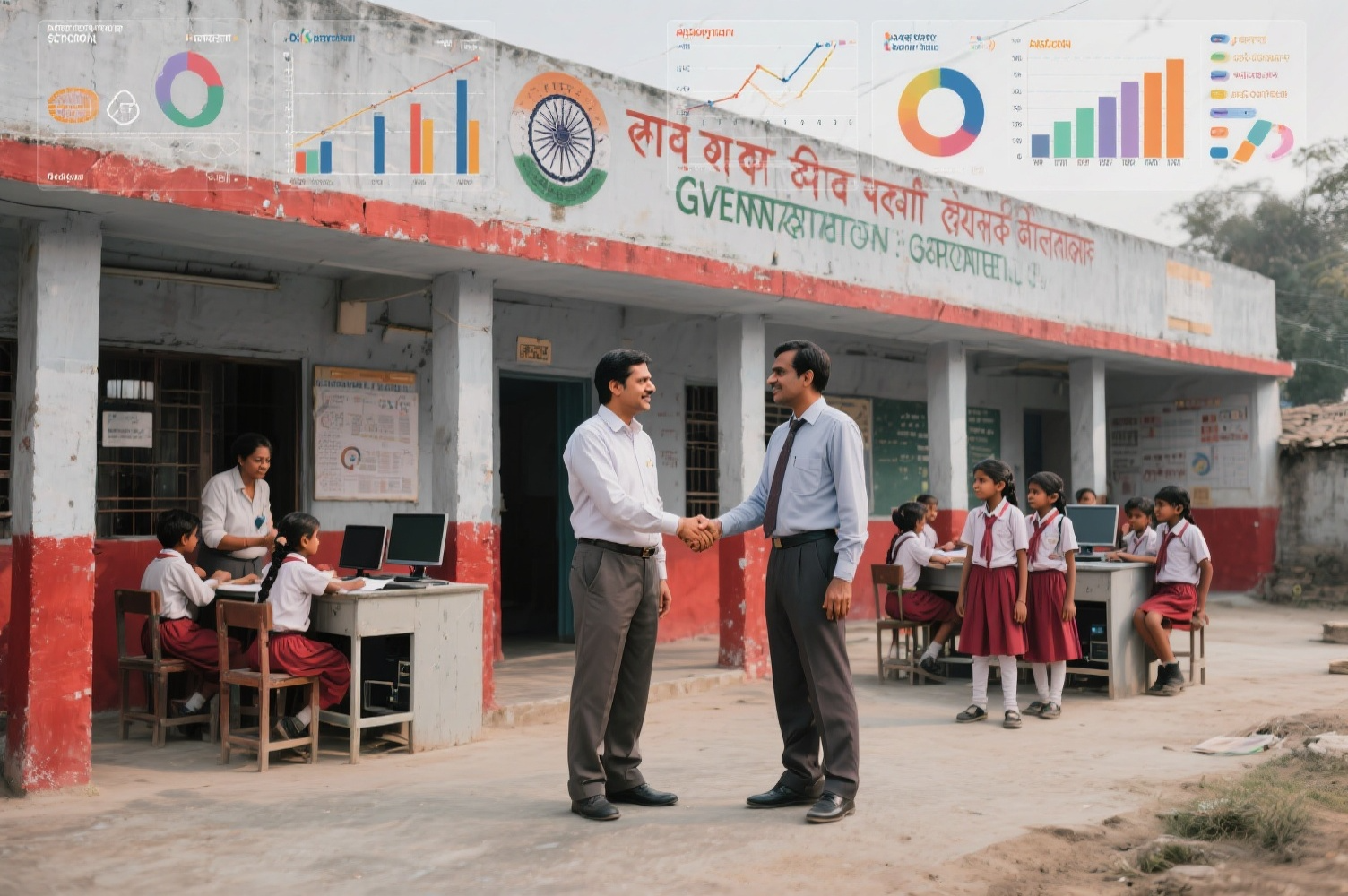- December 9, 2023
- by Educational Initiatives
- Blog
- 0 Comments
A public private partnership (PPP) is a commonly used funding model in public infrastructure projects, like a power plant or an airport. PPPs are becoming increasingly popular and continue to attract significant private investments, mainly where the metrics for success are relatively easy to discern and measure. In industrial projects, these metrics may be the amount of electricity generated, the number of regions serviced at agreed-upon levels, etc. One can consider a customer satisfaction survey as a proxy measure of the effectiveness of an airport maintenance contract, for example.
PPPs have been experimented within the education sector in the last few decades but with mixed results. Some past experiences in PPP in Indian education include:
- Grant-in-aid schools, with the private entity covering expenses for building, infrastructure and classroom resources, and subsidies received from the government largely against teacher / staff salaries. Payment to such schools was not performance linked.
- Infrastructure provision like the ICT enabled computer labs across thousands of government schools operated in the BOOT (Build-Own-Operate-Transfer) model, where a private company gets a contract to operate labs in schools and it recovers its investment through lump-sum/annualised payments from the governments.
- Government provides a capital incentive (payable over a few annual instalments) and a per capita recurring grant to a private entity, which is equal to the actual per student cost incurred by government in running similar government schools, for e.g., the Model Schools where the release of amounts also depended on achieving pre-determined performance standards.
- The Rajasthan Education Initiative (REI) under which the partners like Bharti Foundation operate some schools in rural Rajasthan; Bharti, for example, now operates 192 schools in total across 6 Indian states for nearly 40,000 children, bearing the entire operational costs of the schools. This is an example of a private philanthropic model.
- Governments subsidy on each enrolled student paid to an NGO/ private entity; for e.g. Gyan Shala provides elementary education for out-of-school children. This program was partly funded by the Gujarat government’s Sarva Shikha Abhiyan.
In addition to the above there are other models that are sometimes described as PPP arrangements:
- Impact bonds and result-based financing models: The Development Impact Bonds (DIBs) like the Haryana Early Literacy DIB, Quality Education India DIB are examples where funding from private/ CSR foundations has been leveraged to pay for outcome-based interventions in government schools. A social impact bond (SIB), where the government pays only for the outcomes achieved might be a better example of PPP
- School voucher programs where the government provides a certificate of funding for eligible students or for those from the economically weaker sections; the RTE Act Section 12(1)(c) has been described by some as the largest school voucher programme. Private schools are mandated to reserve 25% of their seats for eligible poor students – with the government reimbursing costs.
- Capacity building initiatives for an education personnel or increasing systemic capacity, for e.g the Gunotsav in primary and secondary schools in Gujarat, or teacher training programs in the state, with the help of non-governmental partners. These partners were chosen through government tenders and assisted in capacity building, school assessments, etc.
What does a PPP in education even mean?
In the prevalent parlance in the education literature and practice in India, almost any project involving government and private resources is sometimes referred to as a PPP. This can be misleading and may defeat the very rationale of PPPs as every service contract is being considered a PPP. We propose that in education, the term PPP should be used only when the following conditions are met:
– the government initiates the process,
– the project involves the delivery of educational service, and
– the project operates at a significant scale.
We can see in the above that if a state has a grant-in-aid programme to operate a number of schools, it meets all the three conditions. With the grant-in-aid programme, the government had subsidised the private sector by paying for teacher salaries for a certain sanction strength to extend the access to schooling and at the time, when the government-aided schools came into picture, they constituted the majority (DISE data reveals they still account for 8% of total school enrolment today). However, if a Civil Society Organisation (CSO) offers to run 10 municipal schools, it meets only the second condition and would not qualify as a PPP. Backend services – for example setting up a technology platform for the government – also do not qualify as PPPs as they do not meet the second condition. A project financed through a social impact bond, based on achieving learning outcomes, affecting only a handful of schools will also not qualify as it is not operating at a scale. PPPs can potentially be efficient ways of contracting the delivery of education, a service that the government is mandated to provide and accountable for ensuring, to a private player for more efficient delivery. The government can choose to contract the whole or parts of the process to a private entity. Thus, the grant-in-aid school model in India and charter schools in the US, in that sense, are PPPs.
There are several implementation challenges that put a question mark over the autonomous arrangements and financial viability of these PPPs. Dependence on philanthropic funding with zero or partial support on operational expenditure by the government blurs the path to sustainability. Where attendance, professional development for teachers, year-end or board examinations are used as proxies for learning outcomes and repeated under performance can result in an annulment of the contract, there is an incentive for operators to provide false outcomes or trying to circumvent the process. The past efforts in PPP deployed in running schools have shown limited success and are inadequate for scaling beyond the 100-500 schools’ subset, primarily because they are not designed for it. It is the government that has to bear the mantle of providing quality education and fulfil its promise of equitable and equal access as a fundamental right of the citizens who have endowed them with this responsibility.
This also calls out the need to re-examine the spin given to the narrative of PPPs, positioning them as a panacea. Merely a capacity building exercise or operating a handful of schools in a localised geography as part of philanthropic activity, where the government does not have a substantial, long term stake and continued responsibility, cannot be termed as PPPs. A government office paying a private player for a service is a service contract and an NGO operating 10 schools is a great use of philanthropic fund, However, both of these do not fulfil all criteria of a PPP, and could be called pilots at best. The PPP arrangements put in place by the Municipal Corporation of Greater Mumbai (MCGM) are closer in spirit, with third party evaluations, performance benchmarking and cost-per-child linked payments, however, in a state with over a lakh schools, doing it for 80 schools still keeps the number minuscule.
The Ministry of Finance, GOI defines PPP in the context of infrastructure sectors as a commercial legal relationship- “an arrangement between a government / statutory entity / government owned entity on one side and a private sector entity on the other, for the provision of public assets and/or public services, through investments being made and/or management being undertaken by the private sector entity, for a specified period of time, where there is well defined allocation of risk between the private sector and the public entity and the private entity receives performance linked payments that conform (or are benchmarked) to specified and pre-determined performance standards“. Such a definition leaves less room for misinterpretation, yet the term PPP continues to be used overarchingly for any education quality improvement effort/ pilot that is undertaken through a private/ non-profit/ non-governmental entity.
The Criticality of Accurate Measurement of Learning Outcomes
The analogy of the customer satisfaction survey as a proxy for the service quality at an airport will make for a poor gauge for sectors like education or health. One cannot rely on customer rating in medicine; a high-quality independent evaluation of the patient will actually reveal whether a course of medicine has worked or has only hidden a few symptoms. Similarly, in education, parental feedback may only ostensibly be useful, because that runs the risk of schools pandering to what parents may be demanding for- such as reduction in fee, providing additional classes, giving a ‘discount’ on certain conditions. It, therefore, warrants a more scientific approach to the measurement of outcomes. In education, success of a PPP hinges significantly on independent, reliable measurement of learning outcomes. However, there is little systemic capacity to able to measure and quantify learning outcomes. Comparable empirical evidence of the outcomes, that these investments ought to generate, are few and far between.
A parallel can be drawn with the Development Impact Bond (DIB) model of funding in education where there is a laser sharp focus on the pre-agreed outcomes. Intermediate evaluation provides a direction to the service provider and they course correct, innovate and adapt. All rewards and consequences are based on periodic independent evaluations and this results-based contract binds the outcomes funders, service providers, and investors by a common goal—the achievement of outcomes. The financial return is contingent on the degree of success, achieved on specific, measurable, attainable, relevant and time-bound goals. If this capacity is replicated in a PPP model, it could be key to making it work. However reliably measuring learning outcomes is a challenge, in the absence of high-quality educational data and availability of a national standard or sample.
Relying on school-leaving examinations, as a proxy for standardised testing, remains sub-par; these exams being widely illustrated for propagating rote learning and are usually not focused on building analytical skills. The understanding of grade-specific competencies and their assessments is a highly data-driven exercise that requires deep expertise. Presence of diverse socioeconomic, linguistic, and geographic groups in the Indian subcontinent increases the complexity in defining performance benchmarks and providing data for improvement. Educational Initiatives (EI), a pioneer of large-scale assessments in India, has been able to measure learning reliably and demonstrate that there is a science to how children learn, and patterns – like misconceptions – that are discernible. It has been able to benchmark student learning levels across the different schooling systems in India and with internationally comparable indicators. This is done through systematic, low stakes testing and can also be used to compare two interventions and conclude which causes better learning. Having led several international, national, state-wide assessments and testing more than 10 million students working with 50+ government and civil society partners, EI has built the capacity to cull customised intelligence from over five billion data points. PPP projects in the education sector ought to be evaluated independently and rigorously, using the data on student learning outcomes and benchmarking data generated by organisations like EI that focus on competency-based testing. This will increase the likelihood of their success and ensure that all the partners are strategically guided by the true north, i.e., making sure schooling results in learning for each child.
Maximising the benefits of a PPP
Since PPPs serve to better a public service that the government was obligated to provide, it should be ensured that areas which utilise private sector efficiencies be identified. PPPs must result in the creation of high-quality outputs that the entire system can benefit from, eventually improving systemic capacity. They should be creatively explored for invigorating institutions that already exist or are required in the system at a certain scale like strengthening DIETs, providing teacher training using both traditional and distance/ICT methods, for building standardised assessments, for building large scale remedial centres, etc. Measuring learning outcomes can be a key metric for determining the success of any of these projects. If we can independently and accurately measure the intermediate achievements and ultimately the improvement in student learning, it will be critical to making any PPP successful. The fundamental goal of education delivery should be our children learning well and it is entirely possible to leverage partners that have complementary strengths to unite for this one common goal.
Sources to be shared if required/requested for-
Sources:
- Public Private Partnerships in India, Department of Economic Affairs, http://www.pppinindia.com/
- Public Private Partnerships in Secondary School Education in India, A Background Paper prepared by the World Bank Group, August 2011, http://documents1.worldbank.org/curated/en/788261505285338479/pdf/119577-WP-IN-PPP-in-secondary-PUBLIC.pdf
- Scheme for setting up of 2,500 Model Schools under Public-Private Partnership (PPP) mode, MHRD website, https://www.mhrd.gov.in/sites/upload_files/mhrd/files/upload_document/Scheme-MS-PPP_-_clean-NEW_0.pdf
- Public-Private Partnerships in School Education: Learning and Insights for India, Central Square Foundation and FICCI School Education Committee, Working paper, March 2014, https://ficciarise.org/wp-content/uploads/2017/06/CSF-FICCI_Public-Private-Partnerships-in-School-Education_Mar2014.pdf



